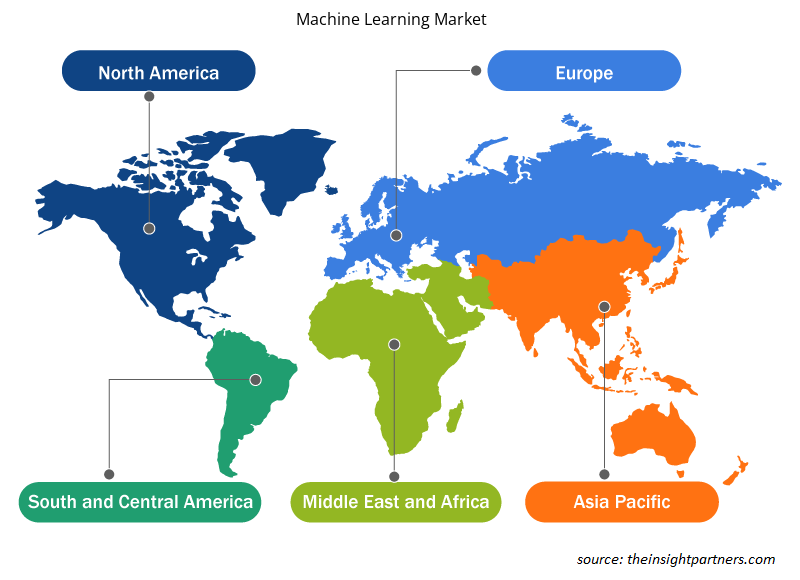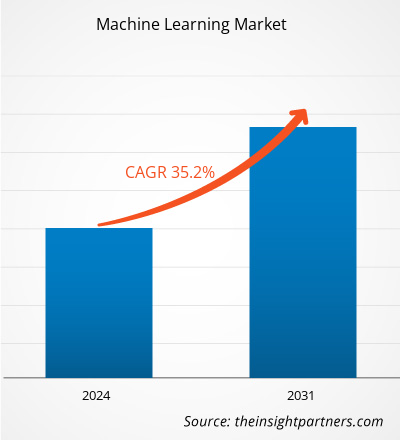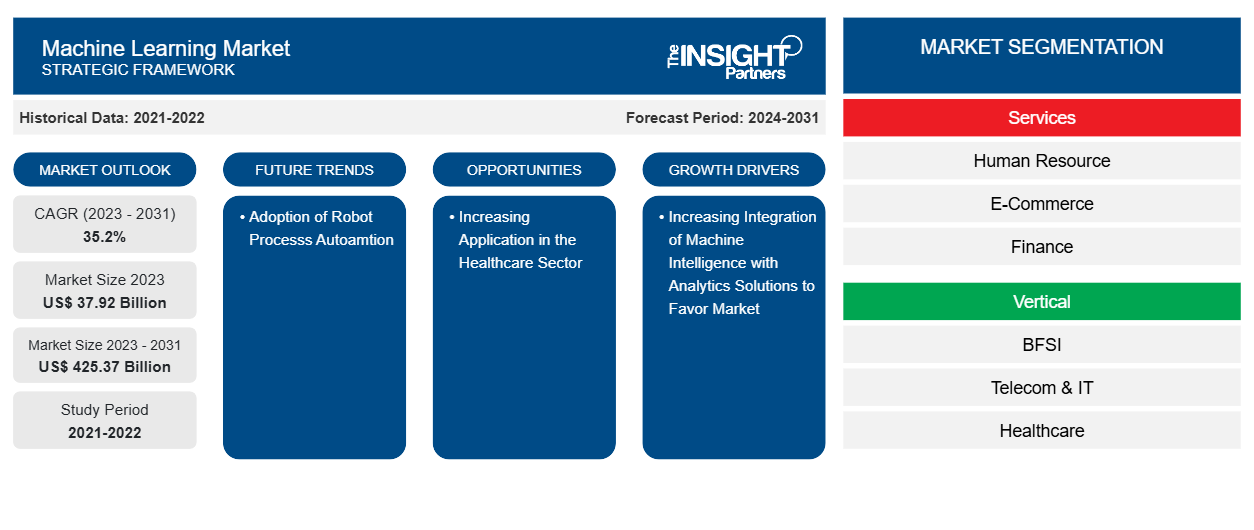机器学习市场规模预计将从 2023 年的 379.2 亿美元增至 2031 年的 4253.7 亿美元。预计 2023-2031 年的复合年增长率为 35.2%。机器智能的不断整合和医疗保健领域的应用不断增加可能仍是机器学习市场的主要趋势。
机器学习市场分析
计算机科学和人工智能的一个分支领域被称为机器学习。为了提高准确性,它专注于数据和算法。使计算机能够从历史数据中学习的技术称为机器学习。机器学习中使用的算法采用多种技术从历史数据中提取知识。数量和历史数据与信息或数据准确性直接相关,这种关系有助于开发更准确的预测未来数据的模型。
机器学习市场概览
由于技术的发展,机器学习是一种新兴技术,并且每天都在扩展。根据组织需求,使用机器学习处理大量数据。人类无法处理大量数据;因此需要计算机系统进行数据分析和管理。机器学习就是这样一种工具。企业内部对管理复杂数据和操作的技术解决方案的需求预计将推动机器学习市场的发展。
定制此报告以满足您的需求
您可以免费定制任何报告,包括本报告的部分内容、国家级分析、Excel 数据包,以及为初创企业和大学提供优惠和折扣
- 获取此报告的关键市场趋势。这个免费样品将包括数据分析,从市场趋势到估计和预测。
机器学习市场驱动因素和机遇
机器智能与分析解决方案的融合日益紧密,市场前景看好
过去几年,零售分析学科取得了长足发展。通过利用尖端的数据分析工具,阿里巴巴、eBay 和亚马逊等众多电子商务公司提高了收入并提升了客户满意度。语音和语音识别技术的研究和开发促成了基于 ML 的认知语音编码技术的出现。
医疗保健领域应用增多,市场前景看好
医疗保健行业的众多应用已经使用了 ML 技术。该平台评估了该行业垂直领域的数百万个独特数据点,预测结果,并提供精确的资源分配和快速的风险评分。
诊断和识别难以诊断的疾病是该技术在医疗行业最重要的用途之一。这可能包括几种早期难以识别的遗传性疾病和癌症。IBM Watson Genomics 就是一个著名的例子,它展示了基于基因组的肿瘤测序与认知计算相结合如何有助于癌症检测。
机器学习市场报告细分分析
有助于得出机器学习市场分析的关键部分是服务和垂直部分。
- 根据服务,机器学习市场分为人力资源、电子商务、财务和会计、客户服务、销售和营销等。预计人力资源部门将在预测期内增长。
- 按垂直行业划分,市场分为 BFSI、电信和 IT、医疗保健、汽车、制造、食品和饮料、电力和能源、消费电子产品等。BFSI 细分市场预计在预测期内将实现增长。BFSI, telecom & IT, healthcare, automotive, manufacturing, food and beverage, power & energy, consumer electronics, and others. The BFSI segment is anticipated to grow in the forecast period.
机器学习市场份额按地区分析
机器学习市场报告的地理范围主要分为五个区域:北美、亚太地区、欧洲、中东和非洲以及南美/南美和中美洲。北美在机器学习市场占据主导地位。北美地区各个行业的高科技采用趋势推动了机器学习市场的增长。数字化采用率的提高和政府机构的高技术支出等因素预计将推动北美机器学习市场的增长。此外,美国和加拿大等发达经济体高度重视研发,迫使北美参与者将技术先进的解决方案推向市场。此外,美国有许多机器学习市场参与者,他们越来越注重开发创新解决方案。所有这些因素都促进了该地区机器学习市场的增长。
机器学习市场区域洞察
Insight Partners 的分析师详细解释了预测期内影响机器学习市场的区域趋势和因素。本节还讨论了北美、欧洲、亚太地区、中东和非洲以及南美和中美洲的机器学习市场细分和地理位置。

- 获取机器学习市场的区域特定数据
机器学习市场报告范围
| 报告属性 | 细节 |
|---|---|
| 2023 年的市场规模 | 379.2亿美元 |
| 2031 年市场规模 | 4253.7亿美元 |
| 全球复合年增长率(2023 - 2031) | 35.2% |
| 史料 | 2021-2022 |
| 预测期 | 2024-2031 |
| 涵盖的领域 | 按服务
|
| 覆盖地区和国家 | 北美
|
| 市场领导者和主要公司简介 |
|
机器学习市场参与者密度:了解其对业务动态的影响
机器学习市场正在快速增长,这得益于终端用户需求的不断增长,而这些需求又源于消费者偏好的不断变化、技术进步以及对产品优势的认识不断提高等因素。随着需求的增加,企业正在扩大其产品范围,进行创新以满足消费者的需求,并利用新兴趋势,从而进一步推动市场增长。
市场参与者密度是指在特定市场或行业内运营的企业或公司的分布情况。它表明在给定市场空间中,相对于其规模或总市场价值,有多少竞争对手(市场参与者)存在。
在机器学习市场运营的主要公司有:
- 亚马逊网络服务公司
- 费埃哲
- 谷歌
- 惠普企业发展有限公司
- IBM
- 微软
免责声明:上面列出的公司没有按照任何特定顺序排列。

- 了解机器学习市场顶级关键参与者概况
机器学习市场新闻和最新发展
机器学习市场通过收集一手和二手研究后的定性和定量数据进行评估,其中包括重要的公司出版物、协会数据和数据库。以下是市场发展列表:
- 2024 年 2 月,领先的算法交易公司之一 XTX Markets 很高兴地宣布推出 XTY Labs,这是一个新的机器学习部门,由新任命的研究主任 Atlas Wang 博士领导。
(来源:XTX Markets,新闻稿,2024 年)
- 2024 年 4 月,使用隐私优先解决方案为程序化广告商提供可衡量价值的机器学习先驱之一 AdTheorent Holding Company, Inc. 和专注于旅游业的战略营销公司 Miles Partnership 公布了 VISIT FLORIDA Sun Seekers 数字广告活动的成果。
(来源:AdTheorent Holding Company, Inc,新闻稿,2022 年)
机器学习市场报告覆盖范围和交付成果
“机器学习市场规模和预测(2021-2031)”报告对以下领域进行了详细的市场分析:
- 范围内涵盖的所有主要细分市场的全球、区域和国家层面的市场规模和预测。
- 市场动态,如驱动因素、限制因素和关键机遇
- 未来的主要趋势
- 详细的 PEST/波特五力分析和 SWOT 分析
- 全球和区域市场分析涵盖主要市场趋势、主要参与者、法规和最新的市场发展。
- 行业格局和竞争分析,包括市场集中度、热图分析、知名参与者和最新发展。
- 详细的公司简介
- 历史分析(2 年)、基准年、预测(7 年)及复合年增长率
- PEST和SWOT分析
- 市场规模、价值/数量 - 全球、区域、国家
- 行业和竞争格局
- Excel 数据集
近期报告
相关报告
客户评价
购买理由
- 明智的决策
- 了解市场动态
- 竞争分析
- 客户洞察
- 市场预测
- 风险规避
- 战略规划
- 投资论证
- 识别新兴市场
- 优化营销策略
- 提升运营效率
- 顺应监管趋势





















 获取免费样品 - 机器学习市场
获取免费样品 - 机器学习市场